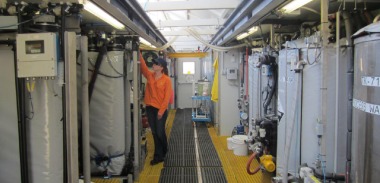Success for uranium-from-phosphate plant
24 September 2012
A portable demonstration plant has achieved "exceptional results" with uranium recoveries of over 90% during steady state operations.
 |
| Inside the portable PhosEnergy plant (Image: UEQ) |
Uranium Equities' (UEQ's) PhosEnergy demonstration plant uses a refined ion exchange process to recover uranium from phosphate streams from the production of phosphate-based fertilizers. The demonstration plant, which is contained inside two shipping containers allowing for easy mobilization and transport, was shipped from Australia to the USA, where it was commissioned in May. Four ten-day tests were completed between June and August using phosphate streams from two different fertilizer facilities.
The operations achieved consistently high uranium recovery of over 90%, with the chemistry of the phosphate stream unaffected except for the removal of uranium, results which UEQ describes as "exceptional." The concentrated product from the operations was shipped to a uranium production facility and can be used to make a "saleable product".
UEQ managing director Bryn Jones described the completion of the plant's first operating phase as a major milestone in the commercialization of the process, to be followed by an engineering study to further increase confidence in capital and operating cost estimates – operating costs are currently estimated to be $25-30 per pound U3O8, with capital costs of $100 per pound of annualized nameplate capacity. The engineering study is expected to begin in the final quarter of 2012.
By-product uranium from the phosphate industry was a major source of uranium production in the 1980s, but the solvent extraction process used at the time had become uneconomic by the 1990s and production ceased. According to UEQ, this means that uranium from phosphates now represents a large stranded resource waiting to be developed. The PhosEnergy process is being commercialized under a strategic alliance between UEQ and Canadian uranium company Cameco.
Researched and written
by World Nuclear News